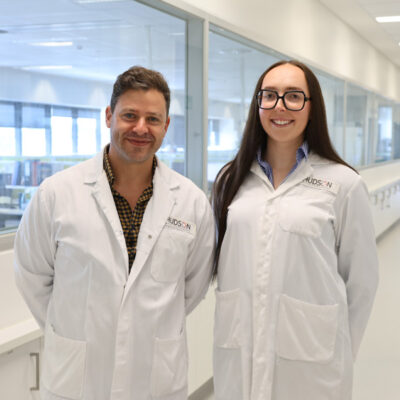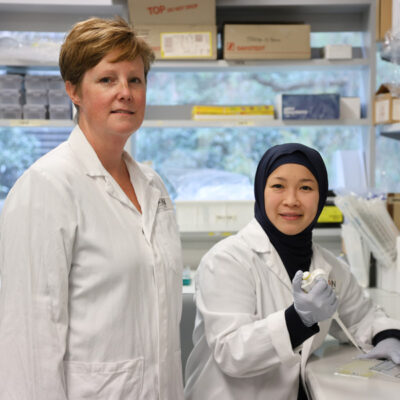Helping newborns—delayed cord clamping clinical trial
By Hudson Institute communications
A breakthrough Hudson Institute discovery which demonstrated how delayed umbilical cord clamping at birth could help newborns, is now underway in an Australian first clinical trial.
Based on the recently published Baby-Directed Umbilical Cord Clamping feasibility study (Baby DUCC) in the journal Resuscitation, the goal of the trial is to understand if babies who stay connected to their mother via the umbilical cord at birth have a smoother entry into the world, including the one in 10 babies who fail to spontaneously breathe. The feasibility study is a collaboration between Hudson Institute, Monash University and The Royal Women’s Hospital.
The original discovery revealed that newborns who need help breathing after birth can be safely assisted by doctors while remaining connected to their mother via the umbilical cord. This could be up to five minutes after birth. Babies who have this continued support from their mother had more stable oxygen levels and heart rates than those whose umbilical cord is clamped immediately at birth. In addition, these babies avoided the potentially dangerous drop in heart rate often seen when a baby’s cord is clamped immediately after birth.
Study lead, Hudson Institute and Monash University PhD student and clinician, Dr Doug Blank explains, “While babies are in the womb, the placenta acts like a lung, providing the baby with oxygen and nutrients. Until a newborn is safely able to breathe by itself, it seems logical that babies should stay attached to the placenta via the umbilical cord for a few minutes after birth until they are breathing well enough on their own to provide their body with the oxygen.”
About 1000 babies born after 32 weeks will be part of the Baby DUCC trial at Monash Health and the Royal Women’s. The team hopes to establish the best physiological indicators for clinicians to use to decide when to cut the umbilical cord. To do this they will use the baby’s vital signs as the deciding factor on when to cut the umbilical cord, rather than a set time.
“The beauty of this technique is that it takes advantage of a powerful, safe, and free resource available to virtually every newborn worldwide – their mother and their placenta.”
“The exciting implication of the study is that it may change the way clinicians help all newborns to breathe after birth, with no need for new equipment, just a change in timing. If it’s successful, this technique could be used in virtually any setting.”
Dr Blank said if the theory is correct, it could dramatically change how babies are delivered globally and could help reduce infant deaths in resource-limited countries where the burden is highest.
“This technique also has the potential to reduce brain damage and potential death from birth asphyxia which affects more than one in a 1000 newborns in Australia. Birth asphyxia is a leading cause of developmental delay and cerebral palsy.”
The next steps would be to conduct a larger trial to see if this technique can reduce death and brain damage from birth asphyxia.
Facts
- More than five per cent of newborns born worldwide need help breathing immediately after birth.
- Worldwide, more than 800,000 newborns die annually because they do not breathe well after birth.
- The majority of newborns that die are born in developing countries but are born at full-term and are otherwise completely healthy.
What is birth asphyxia?
Birth asphyxia is a result of a newborn being deprived of oxygen for long enough during the birth process to cause physical harm, usually to the brain. Worldwide, birth asphyxia claims nearly two percent of all children who die before they reach their fifth birthday. Causes of birth asphyxia include
- Too little oxygen in the mother’s blood before or during birth
- The placenta separates from the womb too early
- Long or difficult delivery
- Problems with the umbilical cord during delivery
- A serious infection in the mother or baby
- High or low blood pressure in the mother
- Baby’s airway is not properly formed
- Baby’s airway is blocked
- Baby’s blood cells cannot carry enough oxygen (anaemia)
Do babies recover from birth asphyxia?
Babies with mild or moderate asphyxia may recover fully. Those babies that have long periods of asphyxia may develop permanent injury, which could affect their brain, heart, lungs, kidneys or other organs.
Team | Douglas Blank, Graeme Polglase, Stuart Hooper (Hudson Institute, Monash University), Peter Davis, Shiraz Bardurdeen, Omar Kamlin, Sue Jacobs, Marta Thio, Jennifer Dawson (Royal Women’s Hospital), Stefan Kane, Alicia Dennis (The University of Melbourne)
Contact us
Hudson Institute communications
t: + 61 3 8572 2697
e: communications@hudson.org.au
About Hudson Institute
Hudson Institute’ s research programs deliver in three areas of medical need – inflammation, cancer, women’s and newborn health. More
Hudson News
Get the inside view on discoveries and patient stories
“Thank you Hudson Institute researchers. Your work brings such hope to all women with ovarian cancer knowing that potentially women in the future won't have to go through what we have!”










